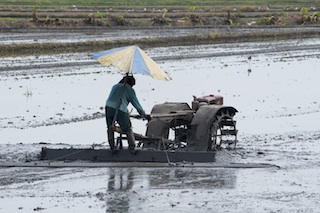Water is a precious resource so improving its use is essential. Adopting proven sustainable agricultural practices reduces water use per bushel. Research, innovation, and access to improved technologies, seeds, and improved irrigation techniques are essential to increasing the efficiency of water use. Agriculture needs to be part of watershed management.
By 2050, the proportion of the population facing stressed water supplies is expected to increase by 500% and the number facing full water scarcity is expected to increase by 800%[1]. Climate variability is expected to impact many major crops , cutting productivity in key food crops like irrigated rice by as much as 27%, rainfed wheat by 25%, and rainfed maize by 15%.
Therefore, farmers must be involved in making crops more resistant to stress and cropping techniques more water efficient. To support them, we must create sound and reliable incentives, share knowledge and we must make adequate tools and technologies accessible to deliver both food and water security.
There are things that can be done to help farmers reduce water use. Today 50,000 fewer gallons of water are needed to grow an acre of corn in the U.S., compared to 20 years ago[2]. It is one step but much more progress is needed.
As key stakeholders in agriculture, the world’s farmers, agronomists, scientists, engineers and industries are working together through an open coalition, to provide innovative solutions which make water use more efficient while increasing agricultural productivity to meet growing food needs.
The Farming First coalition advocates a six-point action plan for enhancing sustainable development through agriculture. In line with these six principles, we encourage stakeholders to pursue policies that achieve long-term global sustainability goals through proven techniques, including specific actions in the area of water use and management:
1. Natural resources

- Protect the integrity of watersheds, wetlands and pasturelands to preserve ecosystem services and biodiversity.
- Invest in technologies and techniques to promote water-use efficiency, such as improved irrigation systems, conservation agriculture and better water allocation systems.
- Retain soil moisture, build up soil organic matter and prevent erosion by applying techniques such as conservation tillage, nutrient management and the use of reclamation varieties[3].
- Facilitate drought-preparedness and mitigation through appropriate technologies, including use of remote sensing, local weather forecasting, drought-tolerant crops, early warning information systems, improved irrigation technologies (based on plant needs through evapo-transpiration), fertigation[4] techniques and building the resilience of rural communities.
2. Share knowledge
- Create international programmes to share best practices for the adoption by farmers of existing water-efficient technologies by making them more affordable, accessible and efficient in use.
- Encourage the use of pilot projects and demonstration plots and develop “train the trainers” programmes for wider dissemination of knowledge.
- Use Integrated Crop Management (ICM) best practices (notably by deploying the right nutrient and other inputs, at the right rate, right time and in the right place to improve nutrient uptake and prevent nitrogen and phosphate runoff or leakage to waterways)[5].
- Use best practices in livestock management to protect watersheds.
- Encourage improved cropping systems (e.g. the use of cover crops and appropriate crop rotation methods, such as nitrogen-fixing legumes), cultivation practices (e.g. by limiting fallow periods and reducing cultivation) and soil-quality practices to increase overall resource productivity and protect soil moisture.
- Provide access to information through “schools on the air” improved media use, and mobile phones.
3. Build local access and capacity

- Invest in infrastructure-building of appropriate, efficient irrigations and fertigation systems.
- Repairing the worst leaks in irrigation channels or investing in low-volume and low-pressure micro irrigation (such as drip and micro-sprayers) will bring huge savings.
- Modest water storage can hugely improve yields in rain-fed agriculture.
- Pumping water into natural aquifers is much cheaper than building dams, as it prevents waste of water through evaporation.
- Flooding rice paddy fields only part of the time cuts water consumption.
- Satellite technology can be used to make water use more efficient.
- Enhancing capabilities to recycle or treat wastewater for use in irrigating some crops. Certain “waste” water has nutrients which can be used in agriculture.
- Secure access to land and water resources, especially for women farmers.
- Provide risk management tools to support farmers in managing weather and market variations.
4. Protect harvests
- Reduce water use by minimising pre- and post-harvest losses.
- Support efforts to enhance food quality and safety and to reduce waste along the food chain through to end-consumers.
- Improve safety testing for food-handling and processing equipment, as well as storage techniques, conservation-chain systems (cold chain, dehydration, drying) and transportation infrastructure.
5. Enable access to markets
- Build infrastructure that allows product to be stored safely and moved to market efficiently to reduce waste. Establish market rewards for using sustainable agricultural practices and acknowledge farmers’ vital role in providing ecosystem services.
- Support farmers’ organisations, enabling them to operate as aggregating agencies bringing together individual farmers to improve access to financial mechanisms, funding and carbon markets.
6. Prioritise research imperatives

- Invest in R&D aimed at scaling up a broad range of new water efficiency technologies and practices.
- Develop climate information services and early warning systems, as well as best possible estimates of weather and climate impacts on crop or forage production, at a temporal and spatial scale useful for vulnerable rural communities.
- Promote partnerships between farmers and scientists to develop adequate and fit-for-use technologies as well as land and water management tools where they are most needed.
- Improve the capacity of a broad range of crops to grow in harsher climates, developing locally-adapted drought-tolerant, salinity-tolerant, and heat-tolerant varieties.

